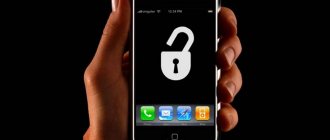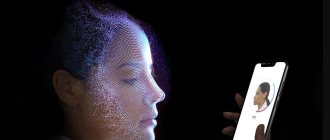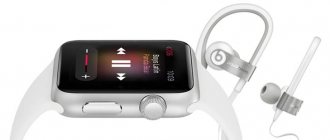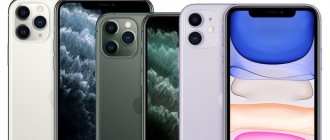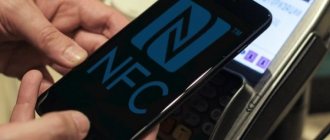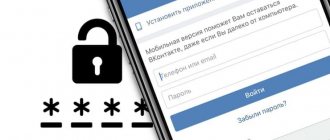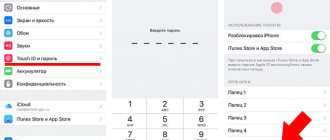As you know, the iPhone X, presented at a special event on September 12, lacks the usual Home button, and the device is unlocked by scanning not a fingerprint, as before, but a face. To identify the user's face, a new technology, called Face ID , uses visible light and infrared radiation.
According to Apple, the system works under a variety of conditions and is super secure.
What is Face ID?
Face ID is a system for biometric user authentication. Unlike a password (something you know) and a hardware key (something you have), biometric authentication requires you. By the way, identifying a user by fingerprints is also biometric authentication.
Touch ID recognizes the user by the pattern on the fingertips, and Face ID recognizes the user by unique facial characteristics. According to the manufacturer, the system is capable of:
- Create a highly accurate initial scan of the face, on the basis of which the user will then be identified.
- Compare the resulting face image with the original scan and recognize the user under different conditions.
- Scan your face in different lighting conditions (even in the dark).
- Update the initial scan in accordance with age-related changes, hairstyle, mustache, different eyebrow shapes, etc.
- Prevent third parties from unlocking your device using photos, disguises, and other methods to gain unauthorized access.
Correct positioning of the phone and face for Face ID to work correctly on iPhone
In order for the system to capture and save a high-quality image, it is necessary to select a suitable room with good lighting. Don't rely entirely on the infrared sensor to help you take photos in dim light. To create the right photo you need:
- Set up the phone to scan the owner's face.
- Place your face straight and towards the light source.
- Place the gadget vertically, that is, the way it is usually held in the hand when surfing the Internet.
- Shooting should be done at arm's length (ideal range from 25 to 50 centimeters).
- The eyes should be looking at the camera at all times. This applies not only to settings, but also to subsequent unlocks.
You need to hold the phone straight, otherwise it may stop scanning your face
What devices use Face ID?
Currently, Face ID technology is only implemented in the iPhone X. The rest of the new and old iPhone models have Touch ID. It is possible that Apple could make the face scanner a premium feature, available only to owners of top-end models. However, judging by past experience, Face ID may well replace the fingerprint sensor in the 2022 models and even in the next updated iPhone SE, if one is destined to appear.
It is likely that the iPad Pro may also receive the new system in the future, but this is unlikely to happen before the second quarter of 2022.
What is Face ID for?
With Face ID, you can do the same things as with Touch ID - make payments through Apple Pay, make purchases in the App Store and other app stores that support Touch ID.
How exactly the process of confirming an in-app purchase using a face scanner will take place is still unclear. Currently, a Touch ID icon appears in apps and the user must place their finger on the sensor. It is not clear whether you will need to first click on the Face ID icon and then scan your face, or whether scanning will occur immediately automatically.
Third-party stores will have access to the facial mapping system, but not at the same level as Apple. Most likely, they will be able to use a “live” image depth map, a new feature in iOS 11 for the two main cameras.
Checking the TrueDepth Camera Operation
Before setting the function, you must make sure that no foreign objects are blocking the camera's view. You can check the camera in the same settings as in the previous paragraph. If it is covered or covered with something, the system will notify the user about this. To start the test, you need to place the phone in front of you in portrait orientation at arm's length or 25-50 centimeters from your face and look directly into the lens.
Why the Internet does not work on an iPhone - what to do
In rare cases, one of the FaceID components may not work due to hardware failure or a manufacturing defect. In this case, you should return the phone under warranty if it was purchased from an official store or ask for a replacement camera.
Note! A breakdown could occur if a non-original (counterfeit) phone was purchased or the gadget was dropped.
Alternative appearance is also enabled from the main settings menu
How to set the initial face scan?
In order to set the initial face image by which the iPhone X can recognize its owner, you need to go to “Settings”, select the “Face ID and password” option and click on “Add face”. Next, using the front camera and infrared sensor, the device will take a photo of your face. The photo will appear on the screen surrounded by green marks, after which lines will appear on the photo to indicate the eyes and nose. You will need to move your photo strictly to the center to get all the necessary facial characteristics.
According to Apple, the chance that someone else will be able to unlock your iPhone by placing their finger on Touch ID is one in 50 thousand. This is a very low figure, given that there is no way to check it. As for Face ID, the chances of a false positive are even lower - one in 1 million. However, as Apple Marketing Director Phil Schiller noted during the iPhone X presentation, the chances increase if the person is closely related to you (for example, a twin).
How to set up face ID on iPhone
Face ID is the main means of user identification. Therefore, any person who buys an iPhone with bangs should think about setting up a face ID.
Apple does not make it difficult to register a face, and therefore offers to create Face ID when you first turn on the device. If this has not been done before, you will need:
- Open settings.
- Go to the “Face ID and Passcode” section.
- Click the “Set up Face ID” button.
But now the registration process will not be different for people who decided to create a face ID right away, and for those who wanted to wait. So, the main thing when creating Face ID is to follow the on-screen instructions.
The user is asked to take the iPhone vertically and, looking directly at the camera, begin to rotate their head to register their identity. After several circular rotations, the system issues a notification that Face ID has been successfully created.
Try to rotate your head slowly so that the neural networks can capture all the features of your face.
How does Face ID work?
The technology uses an infrared emitter (emitter) and a sensor called TrueDepth. With their help, Face ID directs infrared rays from 30 thousand points to the scanned face, and then captures their reflection.
Next, the system analyzes the received data, measuring the depth and angle of reflection of each point, and creates a 3D map of the face.
The same system is used to create Animoji - animated emoji that mimic your facial expressions.
How to unlock iPhone X using Face ID?
Of course, the iPhone doesn't continuously scan your face. First, you need to “wake up” the device using any of the existing methods (lift it or press the corresponding button), and then look at the screen. The system can scan your face even if you are wearing sunglasses, as long as your eyes are open. That is, children will not be able to unlock the iPhone X by holding it close to the face of a sleeping parent.
To prevent spontaneous unlocking, Cupertino has provided an “attention” mode. This means that if you are not looking specifically at your iPhone, but are simply busy doing something on the lock screen, the device will not unlock. This feature can be disabled if desired.
According to the manufacturer, Face ID works even in a dark room. During the presentation of the iPhone X, one of the slides showed a special “illuminator” emitting infrared light, which ensures that the scanner operates in the dark. No visible light is used, so it is impossible to notice the scanning process in any lighting.
Face ID - what it is, how it works
What is Face ID? This is a secure authentication system that can unlock the device and pay for purchases by recognizing the owner's face.
This capability is provided by TrueDepth cameras, the joint work of which scans, perceives and recognizes the structural map of your face. A few words about the components of the system:
- Dot Projector - about 30,000 invisible dots are projected onto your face, creating a personalized map taking into account all the contours of your face;
- Infrared camera – is responsible for the process of reading information about the dot structure, creates an image in the IR spectrum and transfers the data to the Secure Enclave module, which is built into the A11 Bionic processor (at this stage, a match is checked and a comparison is made between the face and the previously specified dot structure of the owner’s face) ;
- IR emitter - emit an invisible beam of infrared light, with which iPhone X recognizes your face even in the dark.
Face ID is a powerful security system that cannot be fooled by photos. To unlock the iPhone X, you need to specifically look at the smartphone - you won’t be able to wake up the smartphone with your eyes closed or looking at the floor. Moreover, the system works even at night. Those who like to experiment with their appearance don’t have to worry: your face ID will react to you, even if you grow a beard, put on glasses, put on makeup, or put on a winter hat and scarf.
By creating a 3D model of the face, the Face ID system is more compromised and easier to use, which cannot be said about the iris scanner from Samsung, where unlocking a smartphone requires clarity and dexterity - matching your eyes and scanners while walking, you see, is more difficult.
How secure is Face ID?
According to Apple's description, Face ID's biometric scanning and matching process is the same as Touch ID's. Biometric data is sent to the Secure Enclave, a special tamper-resistant chip hidden deep in the electronics of the iPhone and iPad.
Because the process occurs locally on the device, Apple does not collect or store biometric data. Even if iPhone X is lost or stolen, no one else will be able to get it. However, many fear that the government will be able to force Cupertino to make changes to the technology they have developed that will allow them to obtain user biometric data and search for people by face. True, in the form in which it is presented now, the iPhone X hardware does not allow anything like that.
Is it possible to fool Face ID?
Most likely, the answer to this question is no. Apple has planned and implemented so many things that it is impossible to outsmart its face scanner. Other similar systems can be fooled by photographs, plaster models, etc., but not Face ID.
Plaster models reflect infrared rays differently than real faces, so they are useless in the case of Face ID.
Does Face ID recognize people of different skin colors equally well?
We hope that Apple has taken into account the mistakes of other manufacturers who use machine learning in their products (there are cases when dark-skinned people could not use a “smart” hand dryer because it recognized their hands by color), and its scanner will recognize people of different races equally well accessories.
Machine learning used to train voice recognition systems, image recognition, etc., is based on databases. It takes hundreds of millions of samples to teach a system to recognize something. Previously, these samples tended to be collected from white men, which caused systems trained using machine learning to perform incorrectly. However, as Apple's senior vice president of software engineering Craig Federighi told TechCrunch, Face ID training samples were collected around the world. According to Phil Schiller, the company managed to capture a billion images, but you need to understand that a billion images does not mean photos of a billion people. The exact number of people whose samples were used to train Face ID is unknown.
The data received by Face ID is stored strictly on the user’s device, which means that the system cannot actually determine the accuracy of the algorithm it uses for an individual person. From a security point of view, this approach is ideal, but it can lead to some rather strange results. “We do not collect user data during Face ID setup; it remains on the device. We don’t send data to the cloud for training,” Federighi said.
How to disable Face ID?
There are several options to disable Face ID:
- You can go to Settings in iOS 11 and disable the scanner.
- You can turn off your smartphone and restart it.
- You can make five wrong attempts and Face ID will turn itself off.
- You can press the power button five times in a row (you can also disable Touch ID on all iPhone models with iOS 11).
- You can press and hold the Power button and Volume button on the opposite side. The power off menu will appear and the face scanner will be disabled at the same time (this method also disables Touch ID on the iPhone 8 and 8 Plus, but not on earlier models).
How to add an additional user
Apple admits that several people can use the same iPhone. Therefore, the device owner has the opportunity to register an additional person.
To register a second person you need:
- Open iPhone settings.
- Go to the “Face ID and Passcode” section.
- Click the “Alternate appearance” button.
After completing these steps, you will be taken to the face registration menu. The process will be no different from what is offered to the first user. The second person also needs to perform slow face rotations.
Sometimes an additional user is registered to improve recognition accuracy.

